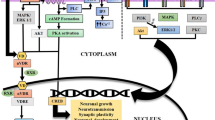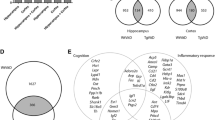Abstract
Vitamin D, a secosteroid hormone, has, over the years, mainly been known for its classic role in the maintenance of calcium homeostasis of the human body. However, there is increasing understanding that vitamin D contributes to the regulation of Ca2+ homeostasis, especially via voltage-gated calcium channels, in another major organ that uses calcium, the brain. Almost 30 years ago, the role of dysregulation in the aging brain and in Alzheimer’s disease (AD) gave rise to the Ca2+ hypothesis of brain aging and dementia. We thus made calcium homeostasis the starting point of our studies, proposing the notion that the consequences of long-term deficiency and/or inefficient utilization of vitamin D may cause the disruption of calcium homeostasis in neurons, this creating a vulnerability of neurons to aging and neurodegeneration. In this mini-review, we aim to describe the potential of vitamin D (cholecalciferol) as a neurosteroid based on our findings and conclusions.

Similar content being viewed by others
References
Sutherland MK, Somerville MJ, Yoong LK, Bergeron C, Haussler MR, McLachlan DR (1992) Reduction of vitamin D hormone receptor mRNA levels in Alzheimer as compared to Huntington hippocampus: correlation with calbindin-28k mRNA levels. Brain Res Mol Brain Res 13:239–250
Poduslo SE, Yin X (2001) Chromosome 12 and late onset Alzheimer’s disease. Neurosci Lett 310:188–190
Blacker D, Wilcox MA, Laird NM, Rodes L, Horvath SM, Go RC, Perry R, Watson B Jr, Bassett SS, McInnis MG, Albert MS, Hyman BT, Tanzi RE (1998) Alpha-2 macroglobulin is genetically associated with Alzheimer disease. Nat Genet 19:357–360
Hollenbach E, Ackermann S, Hyman BT, Rebeck GW (1998) Confirmation of an association between a polymorphism in exon 3 of the low-density lipoprotein receptor-related protein gene and Alzheimer’s disease. Neurology 50:1905–1907
Luedecking-Zimmer E, DeKosky S, Nebes R, Kamboh I (2003) Association of the 3’UTR transcription factor LBP-1c/CP2/LSF polymorphism with late-onset Alzheimer’s disease. Am J Med Gene B 117:114–117
Gezen Ak D, Kahraman H, Dursun E, Süsleyici Duman B, Erensoy N, Alagöl F, Yılmazer S (2005) Polymorphisms at the ligand binding sites of vitamin D receptor gene and osteomalacia. Dis Markers 21:191–197
Gezen-Ak D, Dursun E, Ertan T, Hanagasi H, Gurvit H, Emre M, Eker E, Ozturk M, Engin F, Yilmazer S (2007) Association between vitamin D receptor gene polymorphism and Alzheimer’s disease. Tohoku J Exp Med 212(3):275–282
Lehmann DJ, Refsum H, Warden DR, Medway C, Wilcock GK, Smith DA (2011) The vitamin D receptor gene is associated with Alzheimer’s disease. Neurosci Lett 504:79–82
Beecham GW, Martin ER, Li YJ, Slifer MA, Gilbert JR, Haines JL, Pericak-Vance MA (2009) Genome-wide association study implicates a chromosome 12 risk locus for late-onset Alzheimer disease. Am J Hum Genet 84:35–43
Beydoun MA, Ding EL, Beydoun HA, Tanaka T, Ferrucci L, Zonderman AB (2012) Vitamin D receptor and megalin gene polymorphisms and their associations with longitudinal cognitive change in US adults. Am J Clin Nutr 95:163–178
Beydoun MA, Tajuddin SM, Dore GA, Canas JA, Beydoun HA, Evans MK, Zonderman AB (2017) Vitamin D receptor and megalin gene polymorphisms are associated with longitudinal cognitive change among African-American urban adults. J Nutr 147(6):1048–1062
Dursun E, Alaylioglu M, Bilgic B, Hanagasi H, Lohmann E, Atasoy IL, Candas E, Araz OS, Onal B, Gurvit H, Yilmazer S, Gezen-Ak D (2016) Vitamin D deficiency might pose a greater risk for ApoEvarepsilon4 non-carrier Alzheimer’s disease patients. Neurol Sci 37(10):1633–1643
Gezen-Ak D, Alaylioglu M, Genc G, Gunduz A, Candas E, Bilgic B, Atasoy IL, Apaydin H, Kiziltan G, Gurvit H, Hanagasi H, Ertan S, Yilmazer S, Dursun E (2017) GC and VDR SNPs and vitamin D levels in Parkinson’s disease: the relevance to clinical features. NeuroMolecular Med 19(1):24–40
Gezen-Ak D, Dursun E, Bilgic B, Hanagasi H, Ertan T, Gurvit H, Emre M, Eker E, Ulutin T, Uysal O, Yilmazer S (2012) Vitamin D receptor gene haplotype is associated with late-onset Alzheimer’s disease. Tohoku J Exp Med 228(3):189–196
Annweiler C, Schott AM, Allali G, Bridenbaugh SA, Kressig RW, Allain P, Herrmann FR, Beauchet O (2010) Association of vitamin D deficiency with cognitive impairment in older women: cross-sectional study. Neurology 74(1):27–32
Cherniack EP, Florez H, Roos BA, Troen BR, Levis S (2008) Hypovitaminosis D in the elderly: from bone to brain. J Nutr Health Aging 12(6):366–373
Evatt ML, DeLong MR, Khazai N, Rosen A, Triche S, Tangpricha V (2008) Prevalence of vitamin D insufficiency in patients with Parkinson disease and Alzheimer disease. Arch Neurol 65(10):1348–1352
Llewellyn DJ, Langa KM, Lang IA (2009) Serum 25-hydroxyvitamin D concentration and cognitive impairment. J Geriatr Psychiatry Neurol 22(3):188–195
Llewellyn DJ, Lang IA, Langa KM, Muniz-Terrera G, Phillips CL, Cherubini A, Ferrucci L, Melzer D (2010) Vitamin D and risk of cognitive decline in elderly persons. Arch Intern Med 170(13):1135–1141
McCann J, Ames BN (2008) Is there convincing biological or behavioral evidence linking vitamin D deficiency to brain dysfunction? FASEB J 22:982–1001
Wilkins CH, Sheline YI, Roe CM, Birge SJ, Morris JC (2006) Vitamin D deficiency is associated with low mood and worse cognitive performance in older adults. Am J Geriat Psychiat 14:1032–1040
Fernandes de Abreu DA, Eyles D, Féron F, Vitamin D (2009) a neuro-immunomodulator: implications for neurodegenerative and autoimmune diseases. Psychoneuroendocrinology 34(1):265–277
Garcion E, Wion-Barbot N, Montero-Menei CN, Berger F, Wion D (2002) New clues about vitamin D functions in the nervous system. Trends Endocrinol Metab 13(3):100–105
Brewer LD, Thibault V, Chen KC, Langub MC, Landfield PW, Porter NM (2001) Vitamin D hormone confers neuroprotection in parallel with downregulation of L-type calcium channel expression in hippocampal neurons. J Neurosci 21:98–108
Dursun E, Gezen-Ak D, Yilmazer S (2011) A novel perspective for Alzheimer’s disease: vitamin D receptor suppression by amyloid-beta and preventing the amyloid-beta induced alterations by vitamin D in cortical neurons. J Alzheimers Dis 23(2):207–219
Dursun E, Gezen-Ak D, Yilmazer S (2013) Beta amyloid suppresses the expression of the vitamin d receptor gene and induces the expression of the vitamin d catabolic enzyme gene in hippocampal neurons. Dement Geriatr Cogn Disord 36(1–2):76–86
Gezen-Ak D, Atasoy IL, Candas E, Alaylioglu M, Dursun E (2018) The transcriptional regulatory properties of amyloid beta 1-42 may include regulation of genes related to neurodegeneration. NeuroMolecular Med 20(3):363–375
Gezen-Ak D, Dursun E, Yilmazer S (2013) Vitamin D inquiry in hippocampal neurons: consequences of vitamin D-VDR pathway disruption on calcium channel and the vitamin D requirement. Neurol Sci 34(8):1453–1458
Gezen-Ak D, Dursun E, Yilmazer S (2011) The effects of vitamin D receptor silencing on the expression of LVSCC-A1C and LVSCC-A1D and the release of NGF in cortical neurons. PLoS One 6(3):e17553
Dursun E, Gezen-Ak D, Yilmazer S (2013) A new mechanism for amyloid-beta induction of iNOS: vitamin D-VDR pathway disruption. J Alzheimers Dis 36(3):459–474
Dursun, E., Gezen-Ak D, Yilmazer S (2014) The influence of vitamin D treatment on the inducible nitric oxide synthase expression in primary hippocampal neurons. Arch Neuropsych 51(2):163–168. https://doi.org/10.4274/npa.y7089
Gezen-Ak D, Dursun E, Yilmazer S (2014) The effect of vitamin D treatment on nerve growth factor release (NGF) in hippocampal neurons. Arch Neuropsych 51(2):157–162. https://doi.org/10.4274/npa.y7076
Pearson HA, Peers C (2006) Physiological roles for amyloid beta peptides. J Physiol 575(Pt 1):5–10
Gezen-Ak D, Atasoy IL, Candas E, Alaylioglu M, Yilmazer S, Dursun E (2017) Vitamin D receptor regulates amyloid beta 1-42 production with protein disulfide isomerase A3. ACS Chem Neurosci 8(10):2335–2346
Grimm MOW, Thiel A, Lauer AA, Winkler J, Lehmann J, Regner L, Nelke C, Janitschke D, Benoist C, Streidenberger O, Stotzel H, Endres K, Herr C, Beisswenger C, Grimm HS, Bals R, Lammert F, Hartmann T (2017) Vitamin D and its analogues decrease amyloid-beta (Abeta) formation and increase Abeta-degradation. Int J Mol Sci 18(12). https://doi.org/10.3390/ijms18122764
Mizwicki MT, Menegaz D, Zhang J, Barrientos-Durán A, Tse S, Cashman JR, Griffin PR, Fiala M (2011) Genomic and nongenomic signaling induced by 1α,25(OH)2-vitamin D3 promotes the recovery of amyloid-β phagocytosis by Alzheimer’s disease macrophages. J Alzheimers Dis 29(1):51–62
Mizwicki MT, Liu G, Fiala M, Magpantay L, Sayre J, Siani A, Mahanian M, Weitzman R, Hayden EY, Rosenthal MJ, Nemere I, Ringman J, Teplow DB (2013) 1alpha,25-dihydroxyvitamin D3 and resolvin D1 retune the balance between amyloid-beta phagocytosis and inflammation in Alzheimer’s disease patients. J Alzheimers Dis 34(1):155–170
Masoumi A, Goldenson B, Ghirmai S, Avagyan H, Zaghi J, Abel K, Zheng X, Espinosa-Jeffrey A, Mahanian M, Liu PT, Hewison M, Mizwickie M, Cashman J, Fiala M (2009) 1alpha,25-dihydroxyvitamin D3 interacts with curcuminoids to stimulate amyloid-beta clearance by macrophages of Alzheimer’s disease patients. J Alzheimers Dis 17(3):703–717
Dursun E, Gezen-Ak D (2017) Vitamin D receptor is present on the neuronal plasma membrane and is co-localized with amyloid precursor protein, ADAM10 or nicastrin. PLoS One 12(11):e0188605
Landel V, Stephan D, Cui X, Eyles D, Feron F (2018) Differential expression of vitamin D-associated enzymes and receptors in brain cell subtypes. J Steroid Biochem Mol Biol 177:129–134. https://doi.org/10.1016/j.jsbmb.2017.09.008
Berridge MJ (2017) Vitamin D and depression: cellular and regulatory mechanisms. Pharmacol Rev 69(2):80–92
Landel V, Millet P, Baranger K, Loriod B, Feron F (2016) Vitamin D interacts with Esr1 and Igf1 to regulate molecular pathways relevant to Alzheimer’s disease. Mol Neurodegener 11:22
Mizwicki MT, Norman AW (2009) The vitamin D sterol-vitamin D receptor ensemble model offers unique insights into both genomic and rapid-response signaling. Sci Signal 2(75):re4
Morello M, Landel V, Lacassagne E, Baranger K, Annweiler C, Feron F, Millet P (2018) Vitamin D improves neurogenesis and cognition in a mouse model of Alzheimer’s disease. Mol Neurobiol 55(8):6463–6479. https://doi.org/10.1007/s12035-017-0839-1
Landel V, Annweiler C, Millet P, Morello M, Feron F (2016) Vitamin D, cognition and Alzheimer’s disease: the therapeutic benefit is in the D-tails. J Alzheimers Dis 53(2):419–444
Huhtakangas JA, Olivera CJ, Bishop JE, Zanello LP, Norman AW (2004) The vitamin D receptor is present in caveolae-enriched plasma membranes and binds 1 alpha,25(OH)2-vitamin D3 in vivo and in vitro. Mol Endocrinol 18(11):2660–2671
Kang MJ, Chung YH, Hwang CI, Murata M, Fujimoto T, Mook-Jung IH, Cha CI, Park WY (2006) Caveolin-1 upregulation in senescent neurons alters amyloid precursor protein processing. Exp Mol Med 38(2):126–133
Funding
The reviewed studies performed in Istanbul University, Cerrahpasa Faculty of Medicine Department of Medical Biology, are supported by the Research Fund of Istanbul University (Project No: 23448, 26645, 26263, 27781, 30666, 53653) and by the Scientific and Technological Research Council of Turkey-TUBITAK (Project No: 214S586, 214S585, 115S438, 217S375).
Author information
Authors and Affiliations
Corresponding author
Ethics declarations
Conflict of interest
The authors declare that they have no conflict of interest.
Rights and permissions
About this article
Cite this article
Gezen-Ak, D., Dursun, E. Molecular basis of vitamin D action in neurodegeneration: the story of a team perspective. Hormones 18, 17–21 (2019). https://doi.org/10.1007/s42000-018-0087-4
Received:
Accepted:
Published:
Issue Date:
DOI: https://doi.org/10.1007/s42000-018-0087-4




